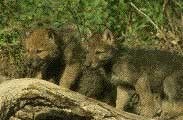
They are listed as endangered by the U.S. Fish and Wildlife Service in 47 states, meaning that throughout all or in a significant portion of its range the gray wolf is in danger of becoming extinct. The Fish and Wildlife Service has listed the wolf as threatened in Minnesota, indicating it is somewhat more secure from extinction there. In Washington State, both the federal and state governments list the wolf as an endangered species. What protection does this listing provide the wolf? The Endangered Species Act, passed in 1973, requires the federal government to protect and conserve species threatened with extinction. The Act makes the "take" of wolves a violation. As defined in the Act, "take" means to "harass, harm, pursue, hunt, shoot, wound, kill, trap, capture, or collect, or to attempt to engage in any such conduct." Will wolves be recovered in the North Cascades? It is mandatory under the Endangered Species Act that federal agencies work toward the wolf's recovery. Recovery is defined as having a population of adequate size and composition to make survival over the long run likely. The wolf recovery program for the Northern Rocky Mountains, prepared by the U.S. Fish and Wildlife Service, includes all of Washington State. Specific population goals for the North Cascades have not yet been determined. Is there a plan to manage wolves? The U.S. Fish and Wildlife Service is the lead agency for protection and recovery of endangered species in the United States. Several natural resource agencies are working toward the conservation and management of the species, including: Animal Damage Control, Bureau of Indian Affairs, U.S. Bureau of Land Management, U.S. Fish and Wildlife Service, U.S. Forest Service, National Park Service, the Washington Department of Fish and Wildlife, and the British Columbia Ministry of the Environment. Are there plans to bring wolves into the North Cascades? No. It appears that wolves are recolonizing their former habitat. Wolves' ability to disperse over long distances and reproduce prolifically may enable the species to reestablish itself in Washington. If wolf numbers increase in the North Cascades ecosystem are any likely to kill and eat domestic sheep or cattle? Wolves rarely prey on domestic stock, but such incidents do happen. Wolves that kill livestock are removed from the area by experts employed by the federal government. Plans have been developed to deal with problem wolves if livestock losses occur in Washington. What threatens the survival of wolves? The loss of habitat, reduction in prey species, and human-induced mortality are the largest threats to their survival. Attitudes about wolves that stem from stories of "the big bad wolf" and sensational journalism may affect their survival even today. Sources of human-induced mortality include poaching, misidentification as coyotes, or as in British Columbia, through predator control and hunting programs. |
Last updated: August 11, 2017
